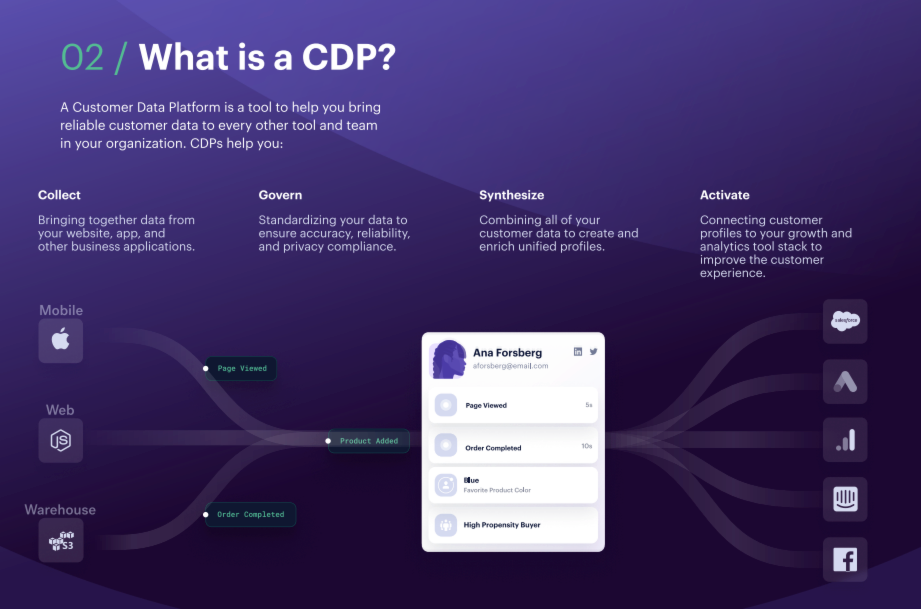Why every developer needs a CDP
Time to read:
Why every developer needs a CDP
Data from customer interactions lends massive value to businesses that can capture, organize, and leverage that data. Sadly, most businesses lack the necessary systems to do this effectively. Manual collection and analysis are time-consuming and aren’t scalable. Turning data into insights and converting those insights into business value is a complex task. How should companies respond?
One option is for companies to ignore the task as unimportant or infeasible. Meanwhile, valuable and actionable customer data passes by them completely untouched.
Another option is for companies to task their engineering teams to build tools and integrations for capturing and analyzing data. Perhaps the results bring value, but those engineering resources are taken away from building features and products that drive the core business.
The third option is the customer data platform (CDP). With a CDP, teams can use a single API to collect all of this data in one place, standardize it, and then send it wherever it needs to go. In this post, we’ll look at the challenge that a CDP addresses, and then we’ll look at how the features of the Twilio Segment CDP address those challenges.
What is a CDP?
A Customer Data Platform (CDP) combines data from every customer interaction and touchpoint with your product or service across various data sources to create a central database. The CDP synthesizes that data to build customer profiles and audiences, helping organizations connect the dots with the tools used to act on that data.
The challenge of capitalizing on customer data
With digital acceleration, a business has access to data from every customer interaction, including mobile app engagement, social media or email campaigns, and customer support contact. Many businesses, however, fail to capture the business value of this customer data.
Some businesses keep their data in silos. Without unifying and correlating customer data across all their channels, they miss out on critical customer insights for deriving business value.
Other businesses commandeer their engineering team to build integrations to centralize customer data from all channels. While this might solve the data silo problem, this also drains engineering resources, pulling them away from their core tasks.
Then, there are businesses that have gained a handle on their customer interaction data, but they haven’t connected that data to their customer communication strategy. When businesses connect data with communication, their customer data insights can advance beyond interesting to game-changing.
The CDP solution


Enter the CDP. A full-fledged CDP helps a company perform the following customer data tasks:
Collect customer data from every source, using APIs for processing, consolidating that data in a single place.
Govern the data that arrives, preparing it for synthesis. This may include validation for correctness or sanitization for privacy concerns.
Synthesize the data to build customer profiles and audience segments while surfacing insights about customer trends and behaviors.
Activate that data by connecting insights to tools for more targeted customer engagement, fine-tuning advertising campaigns, or building machine learning models for predictive behavior.
Twilio Segment is a CDP that provides integrations and an API to connect to your data sources—for data collection and your destinations—for data activation. By providing businesses with integrations to hundreds of data sources and destinations, Twilio Segment frees up the engineering resources of a business to focus on delivering critical business value.
Twilio Segment: Key Features
Let’s consider the key features of Twilio Segment and the benefits of using Twilio Segment.
First, Twilio Segment unifies all of your connections into a single API, simplifying the process of connecting to data sources and destinations. Customer data can come from hundreds of different sources related to analytics, advertising, email campaigns, A/B testing, and more. The integrations with each of these sources have already been built into Twilio Segment.
In most cases, connecting a new data source simply means inserting a JavaScript code snippet or a call to the Twilio Segment SDK. Immediately, customer data from these sources will funnel to Twilio Segment.
By solving the integration problem, Twilio Segment does the heavy lifting of data management, giving valuable time back to your engineers.
Twilio Segment also consolidates, cleans, and organizes your incoming customer data. By configuring data specifications that outline the shape of the data you expect to arrive, you can configure Twilio Segment to handle data that doesn’t fit that shape. That might mean flagging the bad data for review while allowing the good data to continue to sanitization for data privacy concerns or regulations.
With all of your customer data unified into a single view of the customer, Twilio Segment builds a profile based on the customer journey. Twilio Segment organizes and analyzes the data, providing dashboard visualizations so that marketing teams can build out customer segments based on these customer behavior insights.
Twilio Segment integrates tightly with Twilio’s communication platform. This is the game-changing benefit of Twilio Segment: connecting your customer insights with your customer communication. By integrating seamlessly with a suite of developer APIs and tools from Twilio Segment allows you to reach customers on their preferred communication channel: email, voice, video, or messaging.
Lastly, Twilio Segment helps you activate your data further by supporting data warehouses (such as BigQuery, Snowflake, or Redshift) as destinations. Customer data can be sent to data warehouses for querying or leveraging within machine learning applications for further insights. This is exactly what Norrøna, a leading brand of outdoor clothing in Scandinavia, did when it used Twilio Segment as the connector to build its product recommendation engine.
Conclusion
Twilio Segment does the heavy lifting of collecting and processing data from omnichannel customer interactions. As Twilio Segment separates the task of data collection from data analysis, engineering resources aren’t misappropriated for building integrations. Instead, connecting to data sources or destinations is accomplished seamlessly through a single API.
Twilio Segment facilitates the deep analysis work, providing dashboards and visualizations that help teams to understand customer profiles and segments. By connecting these insights to destinations, including Twilio’s extensive customer communication platform, Twilio Segment empowers businesses to capitalize on the wealth of customer data.
For a deeper dive into Twilio Segment, download the whitepaper now.
Ready to see what Twilio Segment can do for you?


The Customer Data Platform Report 2025
Drawing on anonymized insights from thousands of Twilio customers, the Customer Data Platform report explores how companies are using CDPs to unlock the power of their data.
Related Posts
Related Resources
Twilio Docs
From APIs to SDKs to sample apps
API reference documentation, SDKs, helper libraries, quickstarts, and tutorials for your language and platform.
Resource Center
The latest ebooks, industry reports, and webinars
Learn from customer engagement experts to improve your own communication.
Ahoy
Twilio's developer community hub
Best practices, code samples, and inspiration to build communications and digital engagement experiences.


